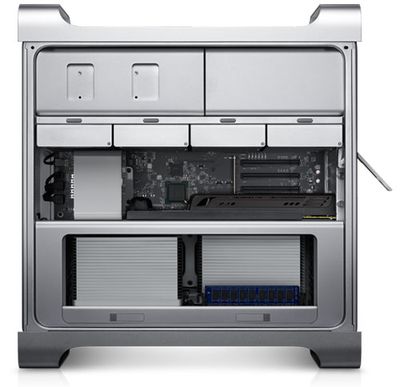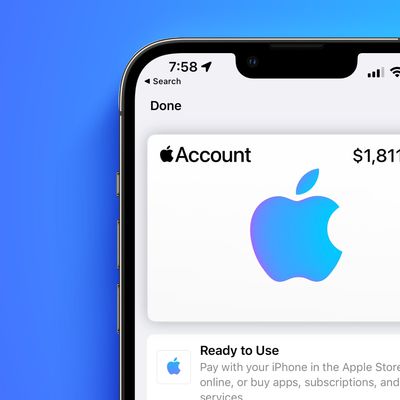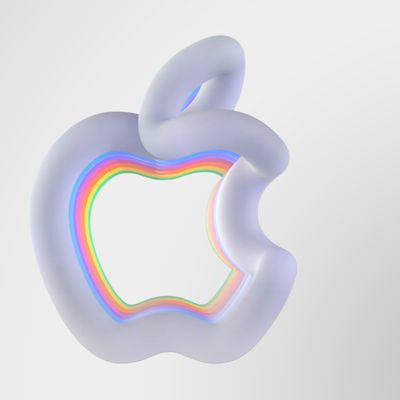Mac Pro to Use Custom Intel CPU? More Details on Mac Mini and Time Capsule
Over the weekend, we heard rumors that Apple will be delivering new Mac minis and Mac Pros in the late July/early August timeframe. Now, MICGadget claims to have new information about these upcoming desktop refreshes and Time Capsule/Airport devices. Much of the information we've seen before, but they do offer some interesting additional notes of interest.
As expected, the new Mac mini will be receiving Thunderbolt and Sandy Bridge processors. As a side effect of this upgrade, the new Mac minis will end up using Intel's HD integrated graphics rather than an NVIDIA solution. This should be no surprise as Apple has made this same compromise in their low-end MacBook Pros using the recent Sandy Bridge processors.

Current Mac Pro design
As for the Mac Pro, MICGadget is also claiming that the new MacPro will be come in a "rack-mountable" design in their new server version to help replace the Xserve. We've
heard this before as well, but they are also claiming that Apple will be using a "unique CPU" developed for the Mac and not seen in the PC.
Sandy Bridge and Thunderbolt are coming to the new Mac Pro, and at the same time, an unique CPU will be developed for Mac. This unique CPU is not seen in PC.
Early MacRumors commenters in the Mac Pro/Mac mini rumor discussion pointed out that Mac Pro-suitable Sandy Bridge processors aren't known to be available in time for the late July/early August timeframe. The use of a custom CPU would explain away this discrepancy. Apple and Intel have a close relationship and are Intel has been known to supply Apple with custom CPU parts in the past. The original MacBook Air also used a custom part that was available only to Apple for a period of time.
As for the Time Capsule and AirPort Extreme, MICGadget claims that the devices are newly designed with better heat dissipation than previous models. They claim that the new TimeCapsule has a lower TDP and low power consumption hard drive using Apple firmware, while the AirPort Extreme has improved signal strength with six antennas built in. Finally, they echo previous claims that the Time Capsule will serve as a caching system for software updates in Lion and iOS 5.
MICGadget has not previously published many original rumors, so their reliability is unknown. The custom Mac Pro CPU, however, rumor fits in nicely with the previous Mac Pro and Mac Mini release timeframe.
Popular Stories
Since the iPhone X in 2017, all of Apple's highest-end iPhone models have featured either stainless steel or titanium frames, but it has now been rumored that this design decision will be coming to an end with the iPhone 17 Pro models later this year.
In a post on Chinese social media platform Weibo today, the account Instant Digital said that the iPhone 17 Pro models will have an aluminum...
Apple is continuing to refine and update iOS 26, and beta three features smaller changes than we saw in beta 2, plus further tweaks to the Liquid Glass design. Apple is gearing up for the next phase of beta testing, and the company has promised that a public beta is set to come out in July.
Transparency
In some apps like Apple Music, Podcasts, and the App Store, Apple has toned down the...
In select U.S. states, residents can add their driver's license or state ID to the Wallet app on the iPhone and Apple Watch, providing a convenient and contactless way to display proof of identity or age at select airports and businesses, and in select apps.
Unfortunately, this feature continues to roll out very slowly since it was announced in 2021, with only nine U.S. states, Puerto Rico,...
Apple will launch its new iPhone 17 series in two months, and the iPhone 17 Pro models are expected to get a new design for the rear casing and the camera area. But more significant changes to the lineup are not expected until next year, when the iPhone 18 models arrive.
If you're thinking of trading in your iPhone for this year's latest, consider the following features rumored to be coming...
Apple is expanding the ability to add an Apple Account Card to the Wallet app to more countries, according to backend Apple Pay changes.
With iOS 15.5, Apple updated the Wallet app to allow users to add an Apple Account Card, which displays the Apple credit balance associated with an Apple ID.
If you receive an Apple gift card, for example, it is added to an Apple Account that is also...
Three out of four iPhone 17 models will feature more RAM than the equivalent iPhone 16 models, according to a new leak that aligns with previous rumors.
The all-new iPhone 17 Air, the iPhone 17 Pro, and the iPhone 17 Pro Max will each be equipped with 12GB of RAM, according to Fixed Focus Digital, an account with more than two million followers on Chinese social media platform Weibo. The...
Apple should unveil the iPhone 17 series in September, and there might be one bigger difference between the Pro and Pro Max models this year.
As always, the Pro Max model will be larger than the Pro model:iPhone 17 Pro: 6.3-inch display
iPhone 17 Pro Max: 6.9-inch displayGiven the Pro Max is physically larger than the Pro, it has more internal space, allowing for a larger battery and...
The calendar has turned to July, meaning that 2025 is now more than half over. And while the summer months are often quiet for Apple, the company still has more than a dozen products coming later this year, according to rumors.
Below, we have outlined at least 15 new Apple products that are expected to launch later this year, along with key rumored features for each.
iPhone 17 Series
iPho...





















